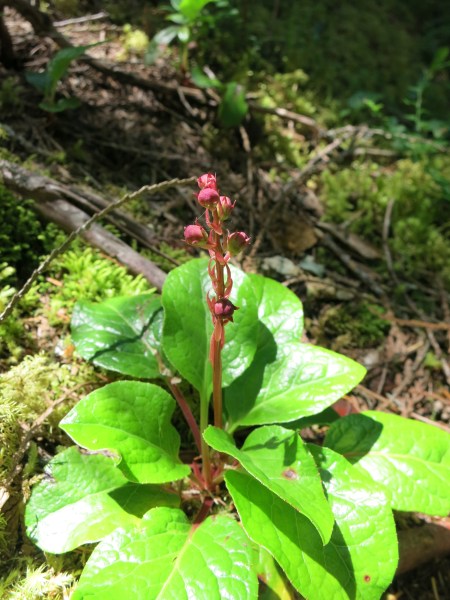This past weekend, my husband and I traveled to the Oregon forest for a lovely wedding. The festivities took place in Camp Sherman, but on the drive back to Portland the day after the wedding we decided to take a little detour to Sahalie and Koosah Falls in Willamette National Forest. It hadn’t occurred to me until we arrived at our hotel in Portland the first night that because we’d be staying in the forest we could potentially see native orchids in bloom! I furiously started googling “native Oregon orchids” and discovered that a few species that do indeed bloom there around this time of year.
With all the wedding celebration I didn’t really spend any time wandering in the woods over the weekend, but our little hike to the falls the day after the wedding turned up a really nice surprise…
We hadn’t been walking down the trail for long when my husband spotted a real, live orchid in bloom! I recognized it from my earlier googling as a Fairy Slipper Orchid (scientific name: Calypso bulbosa). Other nicknames are Venus’ slipper, Calypso orchid, and angel slipper. A bit of basic research taught me that what we saw was the Western Fairy Slipper, or Calypso bulbosa var. occidentalis, rather than the Eastern Fairy Slipper, or Calypso bulbosa var. americana.
My husband took the photos of these orchids, because I was struggling to figure out how to properly use my camera (I really only know how to point and shoot…I should probably learn some photography basics):
How beautiful is that?! The bloom was pretty small—I’d say no more than two inches in height at best. The plant had a single oval green leaf and just that one reddish spike that you see coming up out of the ground. Here’s another look:
Once we spotted that orchid we saw four others blooming in the near vicinity, with additional Fairy Slipper Orchid plants that were not in spike (we could tell from the single leaf growing out of the ground). All were located in cool, shaded areas.
Here’s the best photo of the Fairy Slipper Orchid that my husband snapped:
Simply stunning.
A teenaged girl on the trail saw us peering at and photographing one of these orchids and she stopped and asked us if they were rare. I said I wasn’t sure. Now that I’ve read a little about them online, it looks like they have a pretty wide distribution across the U.S. and Canada but are listed as threatened or endangered in a number of states (Oregon not included). So, rare? Not really. But the Western Fairy Slipper will forever hold a special significance to me because it’s the first native U.S. orchid I’ve ever seen blooming in the wild! It was truly an amazing sight to behold and SO worth the very minor detour we took on the route back to Portland.
I saw a few other plants that I thought *might* be orchids, but after some online research I’m pretty sure they’re not. I’ll post pics here just in case any of you, my dear readers, can confirm either way.
While we were hiking I thought this might be a Coral Root Orchid (Corallorhiza) in bud, but because it has foliage I’m now convinced it’s not:
This one looked like it had a spike poking up so I thought maybe it was some kind of jewel orchid? The foliage doesn’t look quite right, though.
And my husband took a photo of these dried-out blooms during a run in Camp Sherman by the Metolius River; we thought the blooms looked a little orchid-ish:
I was really hoping to see some Lady Slipper Orchids (Cypripedium) but alas, no dice. It’s okay, though, because one wild orchid spotting > zero wild orchid spottings! Math. 🙂
Now would be a great time for a PSA: Never, under ANY circumstances, pick a wild orchid. It’s illegal! Take photos galore, but don’t touch. Leave it be and it will remain happy (also, you won’t go to orchid jail).
I’m also happy to report that half of my Costa Rican orchids are still going. Three of the Brassias have turned brown and dried up, but they weren’t in great shape to begin with. I was worried about leaving them for a few days without any misting (you’re supposed to mist them several times a day at this point) but two of the Brassias and the Epidendrum are still looking good!







2 comments